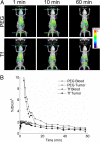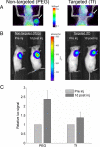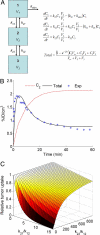Impact of tumor-specific targeting on the biodistribution and efficacy of siRNA nanoparticles measured by multimodality in vivo imaging
- PMID: 17875985
- PMCID: PMC1978218
- DOI: 10.1073/pnas.0707461104
Impact of tumor-specific targeting on the biodistribution and efficacy of siRNA nanoparticles measured by multimodality in vivo imaging
Abstract
Targeted delivery represents a promising approach for the development of safer and more effective therapeutics for oncology applications. Although macromolecules accumulate nonspecifically in tumors through the enhanced permeability and retention (EPR) effect, previous studies using nanoparticles to deliver chemotherapeutics or siRNA demonstrated that attachment of cell-specific targeting ligands to the surface of nanoparticles leads to enhanced potency relative to nontargeted formulations. Here, we use positron emission tomography (PET) and bioluminescent imaging to quantify the in vivo biodistribution and function of nanoparticles formed with cyclodextrin-containing polycations and siRNA. Conjugation of 1,4,7,10-tetraazacyclododecane-1,4,7,10-tetraacetic acid to the 5' end of the siRNA molecules allows labeling with (64)Cu for PET imaging. Bioluminescent imaging of mice bearing luciferase-expressing Neuro2A s.c. tumors before and after PET imaging enables correlation of functional efficacy with biodistribution data. Although both nontargeted and transferrin-targeted siRNA nanoparticles exhibit similar biodistribution and tumor localization by PET, transferrin-targeted siRNA nanoparticles reduce tumor luciferase activity by approximately 50% relative to nontargeted siRNA nanoparticles 1 d after injection. Compartmental modeling is used to show that the primary advantage of targeted nanoparticles is associated with processes involved in cellular uptake in tumor cells rather than overall tumor localization. Optimization of internalization may therefore be key for the development of effective nanoparticle-based targeted therapeutics.
Conflict of interest statement
Conflict of interest statement: M.E.D. is a consultant to and has stock in Calando Pharmaceuticals.
Figures




Similar articles
-
Pretargeted Positron Emission Tomography Imaging That Employs Supramolecular Nanoparticles with in Vivo Bioorthogonal Chemistry.ACS Nano. 2016 Jan 26;10(1):1417-24. doi: 10.1021/acsnano.5b06860. Epub 2016 Jan 12. ACS Nano. 2016. PMID: 26731174 Free PMC article.
-
Physicochemical and biological characterization of targeted, nucleic acid-containing nanoparticles.Bioconjug Chem. 2007 Mar-Apr;18(2):456-68. doi: 10.1021/bc0603539. Epub 2007 Feb 28. Bioconjug Chem. 2007. PMID: 17326672 Free PMC article.
-
Hybrid PET/CT for noninvasive pharmacokinetic evaluation of dynamic PolyConjugates, a synthetic siRNA delivery system.Bioconjug Chem. 2010 Jul 21;21(7):1183-9. doi: 10.1021/bc900558z. Bioconjug Chem. 2010. PMID: 20552976
-
Advanced targeted therapies in cancer: Drug nanocarriers, the future of chemotherapy.Eur J Pharm Biopharm. 2015 Jun;93:52-79. doi: 10.1016/j.ejpb.2015.03.018. Epub 2015 Mar 23. Eur J Pharm Biopharm. 2015. PMID: 25813885 Review.
-
Role of integrated cancer nanomedicine in overcoming drug resistance.Adv Drug Deliv Rev. 2013 Nov;65(13-14):1784-802. doi: 10.1016/j.addr.2013.07.012. Epub 2013 Jul 21. Adv Drug Deliv Rev. 2013. PMID: 23880506 Review.
Cited by
-
Blood-stable, tumor-adaptable disulfide bonded mPEG-(Cys)4-PDLLA micelles for chemotherapy.Biomaterials. 2013 Jan;34(2):552-61. doi: 10.1016/j.biomaterials.2012.09.065. Epub 2012 Oct 15. Biomaterials. 2013. PMID: 23079665 Free PMC article.
-
Design of High-Specificity Nanocarriers by Exploiting Non-Equilibrium Effects in Cancer Cell Targeting.PLoS One. 2013 Jun 26;8(6):e65623. doi: 10.1371/journal.pone.0065623. Print 2013. PLoS One. 2013. PMID: 23840346 Free PMC article.
-
Targeted tumor imaging of anti-CD20-polymeric nanoparticles developed for the diagnosis of B-cell malignancies.Int J Nanomedicine. 2015 Jun 22;10:4099-109. doi: 10.2147/IJN.S78995. eCollection 2015. Int J Nanomedicine. 2015. PMID: 26124662 Free PMC article.
-
Cyclodextrin-containing polymers: versatile platforms of drug delivery materials.J Drug Deliv. 2012;2012:262731. doi: 10.1155/2012/262731. Epub 2012 Feb 2. J Drug Deliv. 2012. PMID: 22496980 Free PMC article.
-
Prednisolone-containing liposomes accumulate in human atherosclerotic macrophages upon intravenous administration.Nanomedicine. 2015 Jul;11(5):1039-46. doi: 10.1016/j.nano.2015.02.021. Epub 2015 Mar 17. Nanomedicine. 2015. PMID: 25791806 Free PMC article. Clinical Trial.
References
-
- Matsumura Y, Oda T, Maeda H. Gan To Kagaku Ryoho. 1987;14:821–829. - PubMed
-
- Soutschek J, Akinc A, Bramiage B, Charisse K, Constien R, Donoghue M, Elbashir S, Geick A, Hadwiger P, Harborth J, et al. Nature. 2004;432:173–178. - PubMed
-
- Song E, Zhu P, Lee S-K, Chowdhury D, Kussman S, Dykxhoorn DM, Feng Y, Palliser D, Weiner DB, Shankar P, et al. Nat Biotechnol. 2005;23:709–717. - PubMed
-
- Zimmermann TS, Lee ACH, Akinc A, Bramlage B, Bumcrot D, Fedoruk MN, Harborth J, Heyes JA, Jeffs LB, John M, et al. Nature. 2006;441:111–114. - PubMed
Publication types
MeSH terms
Substances
Grants and funding
LinkOut - more resources
Full Text Sources
Other Literature Sources
Molecular Biology Databases

